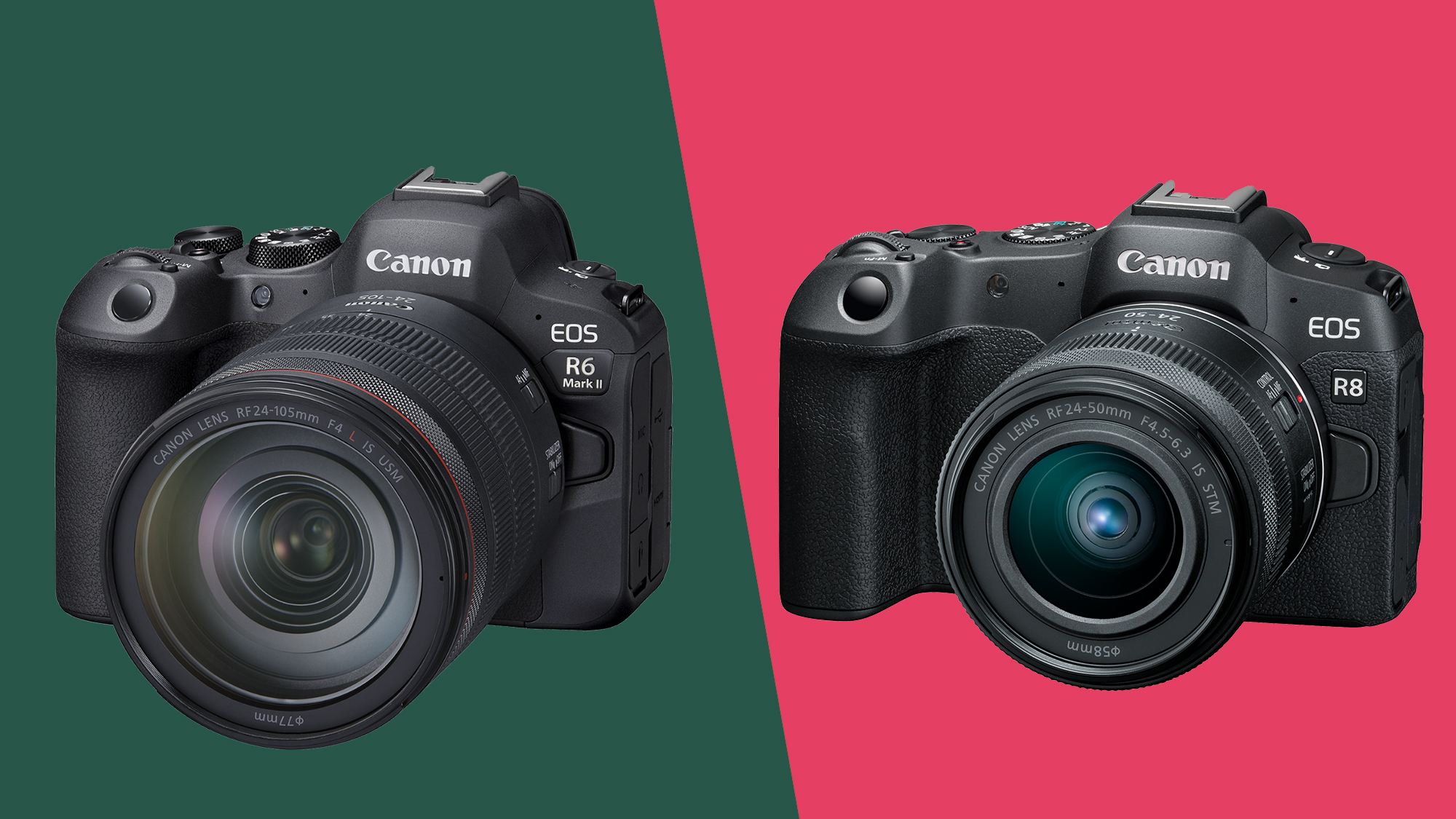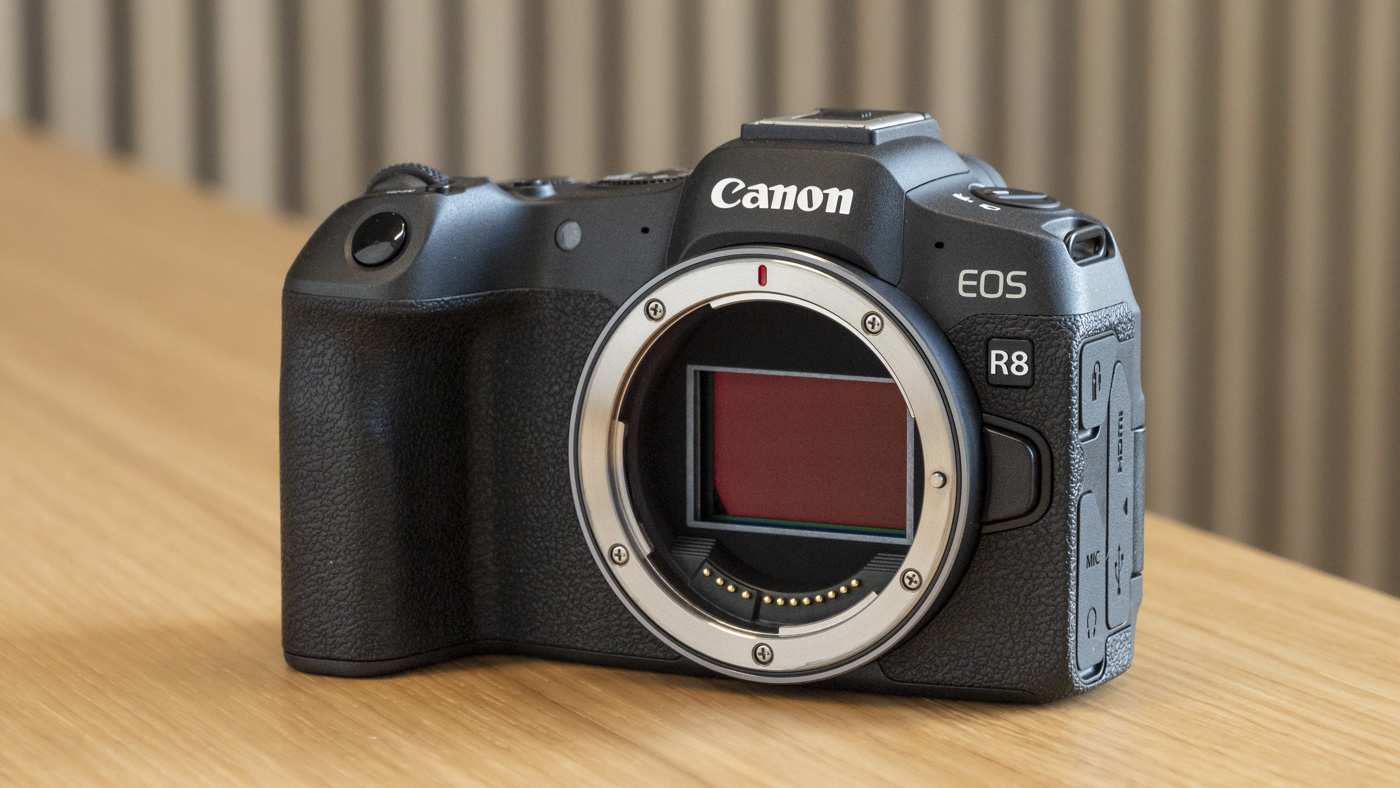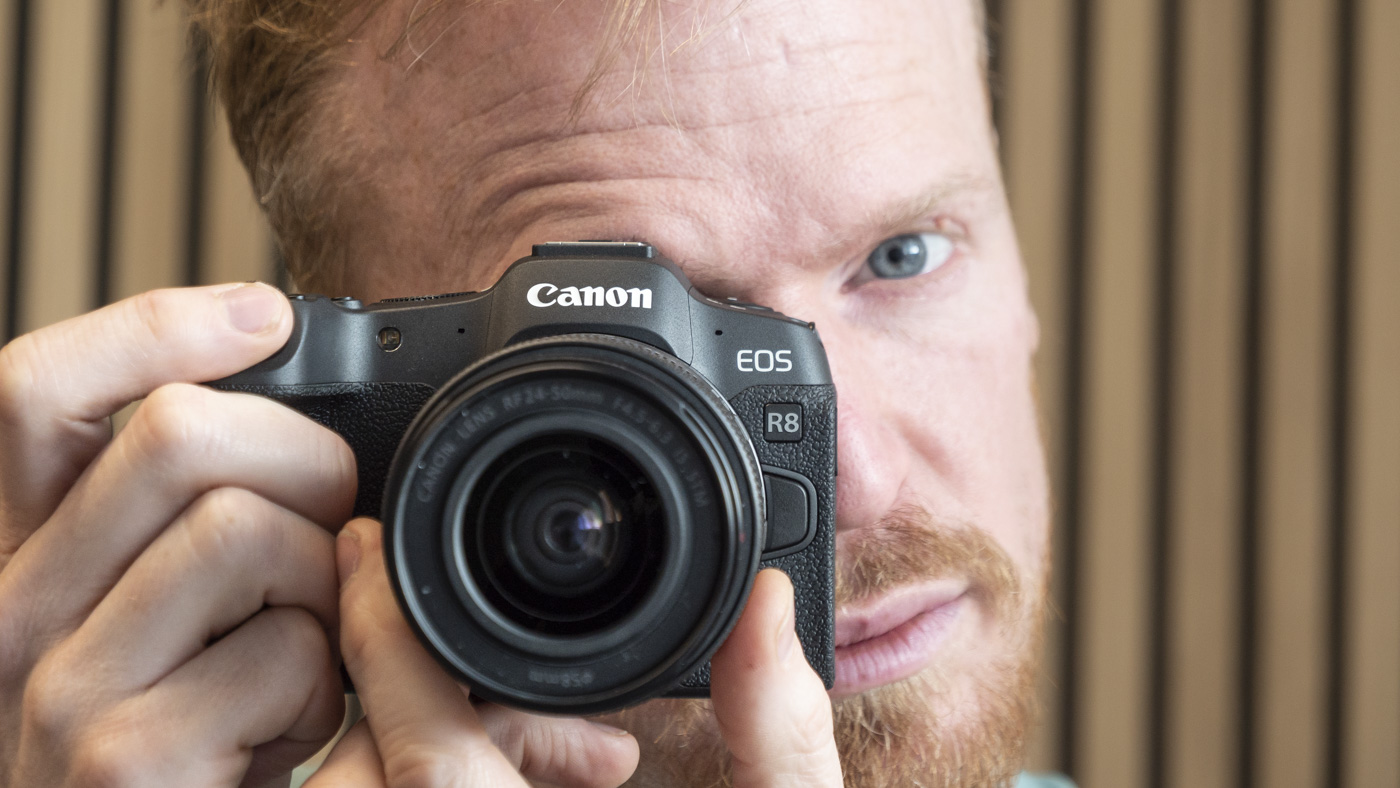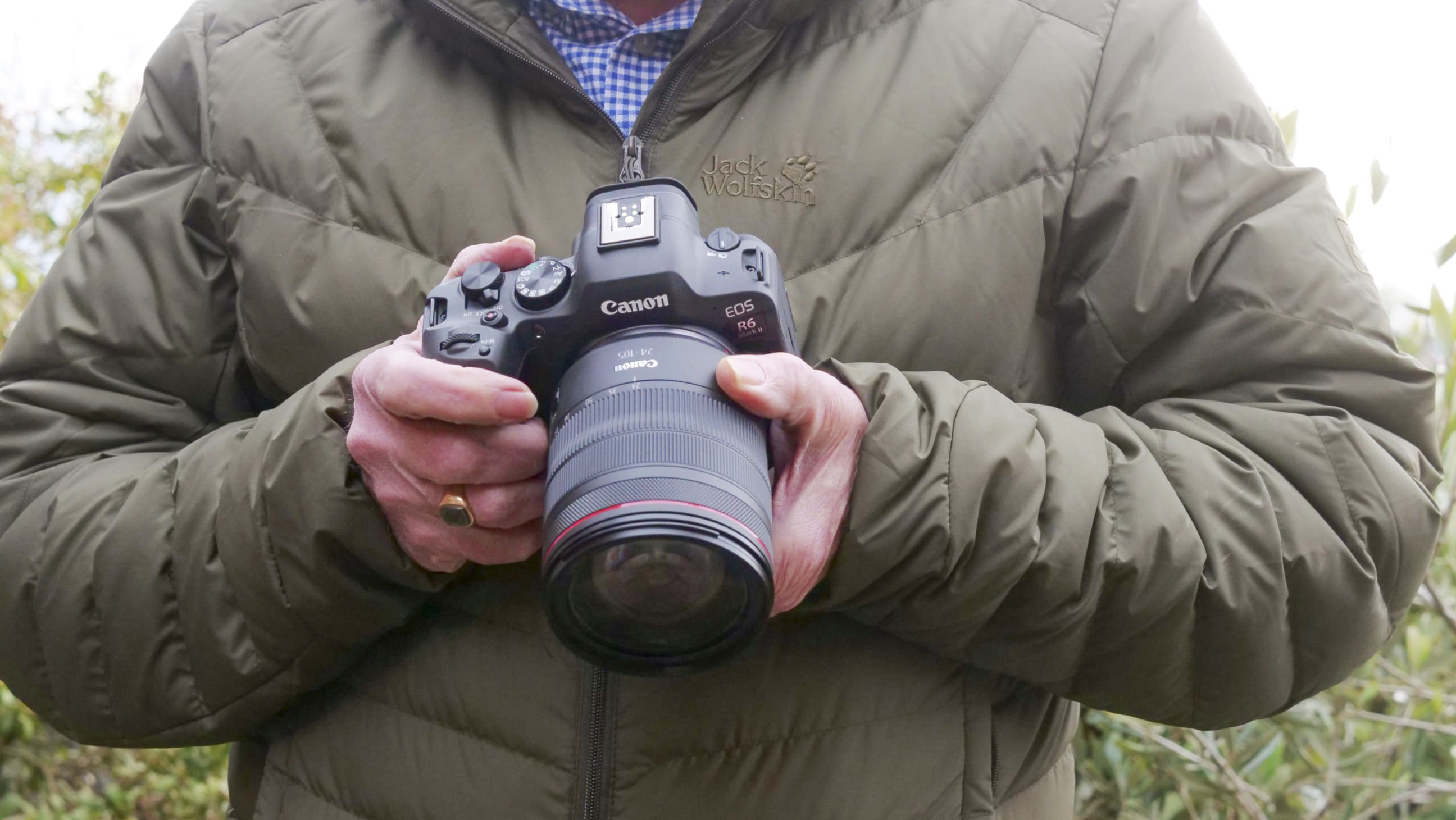Canon EOS R8 vs R6 Mark II: the differences explained
How much is IBIS really worth?

A full-frame professional workhorse that doesn’t skip a beat
Pros
- Excellent autofocus
- Impressive ISO handling
- Versatile 4-axis touchscreen
- 8-stops IBIS
Cons
- IBIS won’t replace your gimbal
- Expensive compared to rivals
Much of the EOS R6 II tech, in Canon's lightest full-frame mirrorless camera
Pros
- Same sensor as EOS R6 II
- Canon's lightest full-frame
- Excellent video features
- Decent price for a Canon
Cons
- Modest battery life
- Basic control layout
- No IBIS
The Canon EOS R8 is a cheaper alternative to the EOS R6 Mark II. It’s more approachable, lighter, and smaller. But is it a better buy than one of the best Canon cameras - the EOS R6 II?
For many it probably is, thanks to the large price disparity and only moderate separation in features that may not affect everyone’s use all that much.
One big difference is in-body image stabilization (IBIS), which is only found in the EOS R8, as is 6K video shooting, and longer battery life. However, as they share the same full-frame 24.2MP sensor, those looking for a mirrorless camera should certainly consider the Canon EOS R8.
Below, we've summarised all of the key differences between the two Canon shooters to help you choose which will better suit your needs, comparing and contrasting the specs and features. For more in-depth information, check out our Canon EOS R8 hands-on review and Canon EOS R6 Mark II full review.

Canon EOS R8 vs R6 Mark II: Price and Availability
The Canon EOS R8 is a significantly cheaper camera than the EOS R6 Mark II. It sits between the EOS R7 and R10 at $1,499 / £1,699 / AU$3,000 (approx) body-only, and $1,699 / £1,899 / AU$3,300 (approx) with a kit lens.
Canon’s EOS R6 Mark II is $2,499 / £2,779 / AU$4,499 body-only, and kit lens packages head up to $3,599 / £3,999 / AU$6,399.
There’s a big cost difference here, but not that substantial a gap in time between their releases; the Canon EOS R6 Mark II was announced in November 2022, just three months before the February 2023 launch of the EOS R8.
Sign up for breaking news, reviews, opinion, top tech deals, and more.

Canon EOS R8 vs R6 Mark II: Design
The Canon EOS R8 is a much smaller and lighter camera than the EOS R6 Mark II. Card and battery in tow, the Canon EOS R8 weighs 461g, whereas the Canon EOS R6 Mark II weighs 670g. The EOS R8’s style is closer to that of the EOS RP, Canon’s popular entry-level full-frame mirrorless camera from 2019, with fewer customizable buttons on the camera exterior.
The 133 x 85 x 70mm EOS R R8 is a bit smaller than the 138.4 × 98.4 × 88.4mm EOS R6 Mark II in every dimension — width being the least impactful. Their control schemes are quite similar too, but the R8 lacks the EOS R6 Mark II’s little multi-function joystick controller up near the EVF, which can be useful for selecting your focal point.
These cameras have comparable constructions, using a magnesium shell largely hidden by the tough polycarbonate plastic exterior. There’s no immediate indication as to if the Canon EOS R6 Mark II has better weatherproofing.

Canon EOS R8 vs R6 Mark II: Sensor and burst shooting
The Canon EOS R8 and R6 Mark II use the same sensor, a full-frame 24.2-megapixel chip. They have the same processor too, the DIGIC X. This means you can expect very similar images from these cameras when used at the same settings. However, the shooting experience is quite different.
The Canon EOS R6 Mark II has in-body image stabilization (IBIS), with up to 8 stops of shake compensation when used with the stabilized Canon 24-105mm kit lens. It won’t be that good when used with non-IS lenses, but handheld shooting will be much more forgiving in the R6 Mark II than the EOS R8.
This also has a hand in making the EOS R8 significantly smaller and lighter. It’s possibly a dispiriting combo — a lighter body is great for casual street photography, but IBIS could be really handy in such scenarios later in the day as the light level drops.
As these cameras have the same processor and sensor they, unsurprisingly, have roundly comparable burst modes. Either can shoot at up to 40fps with the electronic shutter - the EOS R6 II’s burst buffer allows for 190 JPEG or 75 RAW images using the 40fps mode, which betters 120 JPEG and 56 RAW images of the Canon EOS R8.

Canon EOS R8 vs R6 Mark II: Video
The Canon EOS R6 Mark II and EOS R8 video modes are largely evenly matched, at least until you get outboard equipment involved.
Canon’s higher-end R6 Mark II offers a 6K capture mode when used with an external recorder, over the camera’s HDMI port. The EOS R8 does not have such a mode, meaning the camera’s limits when outputting over HDMI are the same as in- camera.
Both can shoot 4K / 60p, and this mode uses 6K oversampling. That means the full width of the sensor is used, and the additional information — because the sensor resolution is actually much higher than 4K — is used to improve picture quality. Alternatively, you can shoot Full HD at frame rates of up to 180fps, and the more common 120fps is an option too.
There’s no 4K / 120p in either camera, which is less glaring in a more affordable model like the EOS R8. Both cameras use a micro HDMI connector for external recording and have headphone and microphone inputs. Video shooters are fairly well served, and as you’d hope, they have access to Canon’s C-Log 3 flat shooting mode to grade color manually after shooting.
Neither camera has a hard shooting time limit, and Canon says the EOS R6 Mark II should be able to shoot for at least 40 minutes when using the top 4K/60p mode. Whether you see the overheating error message or not will depend in part on ambient temperatures, but the hard limit headaches of the past have largely been fixed.

Canon EOS R8 vs R6 Mark II: AF, Display and EVF
As these cameras have the same processor and sensor, it makes sense the Canon EOS R8 and EOS R6 Mark II also share the same Dual Pixel CMOS AF II autofocus system.
They are both rated for lock-on down to -6.5EV, and the focus tracking types include eye, face, head, body, animals (cats, dogs, birds and now horses) and vehicles (cars, motor bikes, aircrafts and trains).
EVF quality is similar, too. The EOS R6 Mark II and EOS R8 have 3.69m-dot electronic viewfinders with a refresh rate of up to 120Hz. Neither is a show-stopper, but they will offer a good-quality image preview. The R6’s magnification is better, though, at 0.76x to the EOS R8’s 0.7x, which makes the image appear larger.
Canon has adopted a new vari-angle style for the Canon EOS R8’s rear display. The EOS R6 Mark II already has a vari-angle screen, of course, but we’ll check out whether this new design is an improvement in our Canon EOS R8 review.

Canon EOS R8 vs R6 Mark II: Connectivity and battery life
The Canon EOS R6 Mark II gets a better spread of wireless connectivity standards than the EOS R8. It supports Bluetooth 5.0 rather than 4.2, and has 5GHz Wi-Fi as well as 2.4GHz. The EOS R8 only supports 2.4GHz, limiting peak transfer speeds.
That alone is probably not enough to sway too many buyers, but some other factors may be. The Canon EOS R6 Mark II offers two card slots, while the EOS R8 has just one. A single slot may be a deal-breaker for the jobbing professional who wants dual recording to avoid the nightmare scenario of losing an entire shoot because of a corrupted card.
The Canon EOS R6 Mark II also has a much higher capacity battery. It’s rated for 760 shots when using the rear LCD, and 450 when using the EVF. This is almost double the longevity of the Canon EOS R8, which again may limit the latter’s pro-use suitability.

Which one should you buy?
The Canon EOS R8 is a surprisingly capable camera considering how much less it costs than the EOS R6 Mark II. You can expect similar stills, and similar in-camera 4K video.
However, the feel of using the EOS R8 handheld will be quite different. It’s a smaller and lighter camera, plus it lacks IBIS, which is going to have a huge impact if you use a non-IS lens.
Other limitations may rule the EOS R8 out for pro-level shooters, but it looks like a good fit for those who want a full-frame mirrorless camera without spending a fortune.

Andrew is a freelance journalist and has been writing and editing for some of the UK's top tech and lifestyle publications including TrustedReviews, Stuff, T3, TechRadar, Lifehacker and others.
- Timothy ColemanCameras editor